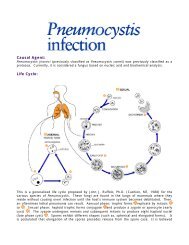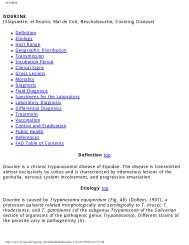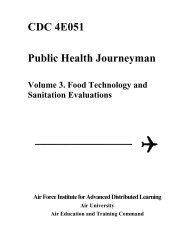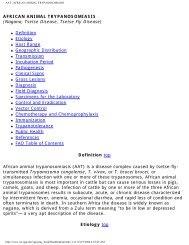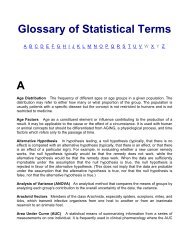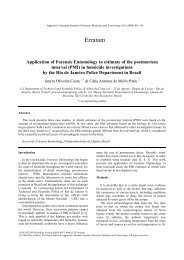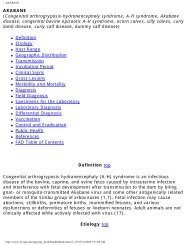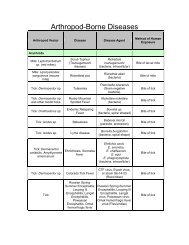Causal Agent: Life Cycle:
Causal Agent: Life Cycle:
Causal Agent: Life Cycle:
You also want an ePaper? Increase the reach of your titles
YUMPU automatically turns print PDFs into web optimized ePapers that Google loves.
<strong>Causal</strong> <strong>Agent</strong>:<br />
The nematode (roundworm) Gnathostoma spinigerum and Gnathostoma hispidum, which infects<br />
vertebrate animals. Human gnathostomiasis is due to migrating immature worms.<br />
<strong>Life</strong> <strong>Cycle</strong>:<br />
In the natural definitive host (pigs, cats, dogs, wild animals) the adult worms reside in a tumor<br />
which they induce in the gastric wall. They deposit eggs that are unembryonated when passed in<br />
the feces . Eggs become embryonated in water, and eggs release first-stage larvae . If<br />
ingested by a small crustacean (Cyclops, first intermediate host), the first-stage larvae develop into<br />
second-stage larvae . Following ingestion of the Cyclops by a fish, frog, or snake (second<br />
intermediate host), the second-stage larvae migrate into the flesh and develop into third-stage<br />
larvae . When the second intermediate host is ingested by a definitive host, the third-stage<br />
larvae develop into adult parasites in the stomach wall . Alternatively, the second intermediate<br />
host may be ingested by the paratenic host (animals such as birds, snakes, and frogs) in which the<br />
third-stage larvae do not develop further but remain infective to the next predator . Humans
ecome infected by eating undercooked fish or poultry containing third-stage larvae, or reportedly<br />
by drinking water containing infective second-stage larvae in Cyclops .<br />
Geographic Distribution:<br />
Asia, especially Thailand and Japan; recently emerged as an important human parasite in Mexico.<br />
Clinical Features:<br />
The clinical manifestations in human gnathostomiasis are caused by migration of the immature<br />
worms (L3s). Migration in the subcutaneous tissues causes intermittent, migratory, painful,<br />
pruritic swellings (cutaneous larva migrans). Migration to other tissues (visceral larva migrans),<br />
can result in cough, hematuria, and ocular involvement, with the most serious manifestations<br />
eosinophilic meningitis with myeloencephalitis. High eosinophilia is present.<br />
Laboratory Diagnosis:<br />
Removal and identification of the worm is both diagnostic and therapeutic.<br />
• Microscopy<br />
Treatment:<br />
Surgical removal or treatment with albendazole* or ivermectin* is recommended.<br />
* This drug is approved by the FDA, but considered investigational for this purpose.





